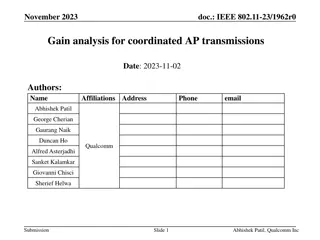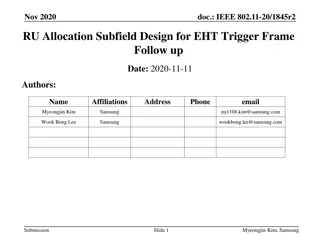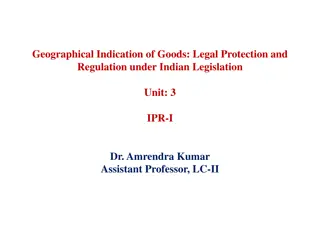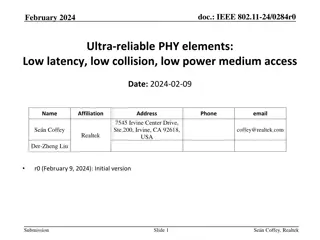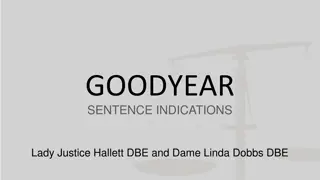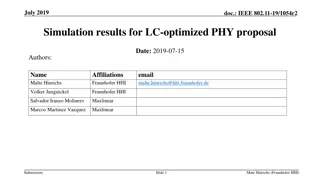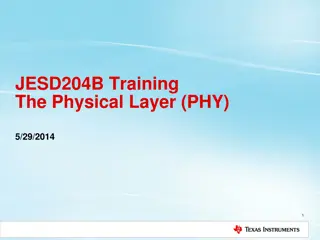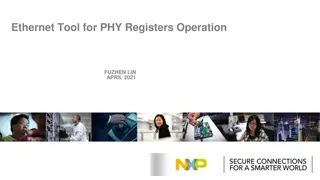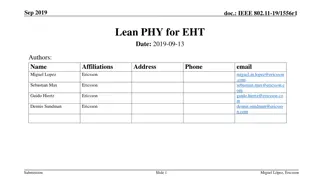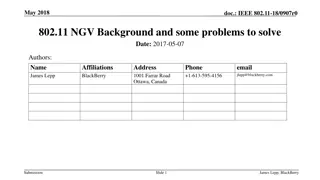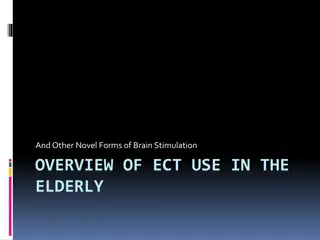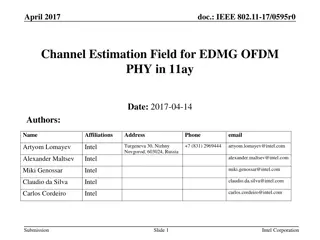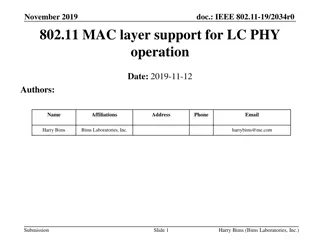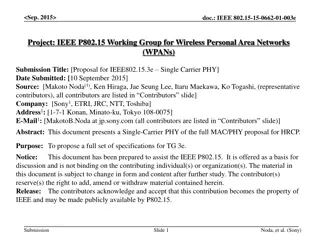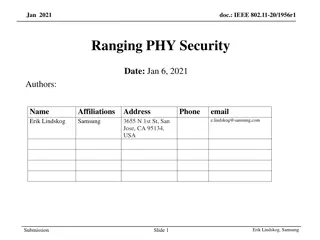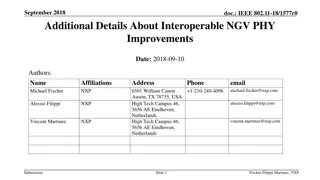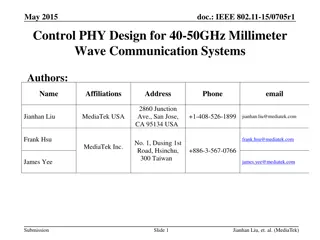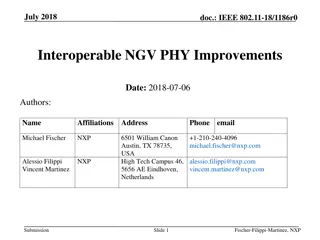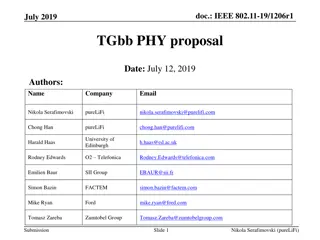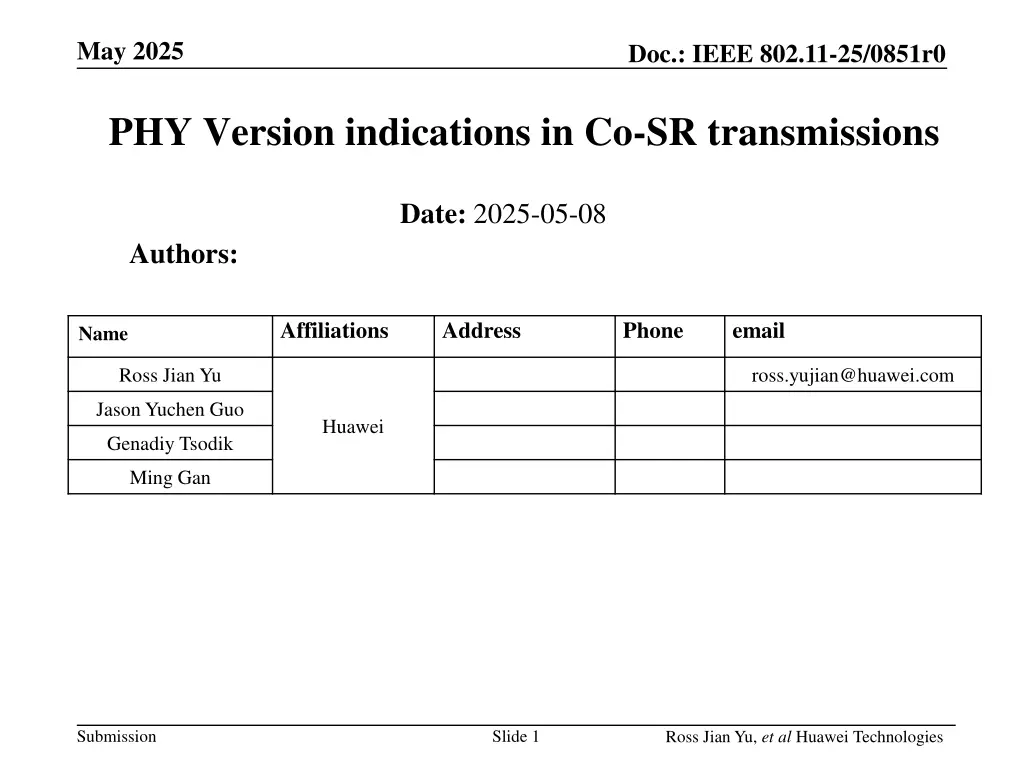
IEEE 802.11-25/0851r0 PHY Version Indications in Co-SR Transmissions
Explore the proposal focusing on information exchange during Co-SR transmissions, particularly on PHY version indications in IEEE 802.11-25/0851r0. The document covers background information, modes of Co-SR transmissions, signaling details, and options for PHY version exchange during Co-SR invite and response scenarios.
Download Presentation

Please find below an Image/Link to download the presentation.
The content on the website is provided AS IS for your information and personal use only. It may not be sold, licensed, or shared on other websites without obtaining consent from the author. If you encounter any issues during the download, it is possible that the publisher has removed the file from their server.
You are allowed to download the files provided on this website for personal or commercial use, subject to the condition that they are used lawfully. All files are the property of their respective owners.
The content on the website is provided AS IS for your information and personal use only. It may not be sold, licensed, or shared on other websites without obtaining consent from the author.
E N D
Presentation Transcript
May 2025 Doc.: IEEE 802.11-25/0851r0 PHY Version indications in Co-SR transmissions Date: 2025-05-08 Authors: Affiliations Address Phone email Name Ross Jian Yu ross.yujian@huawei.com Jason Yuchen Guo Huawei Genadiy Tsodik Ming Gan Submission Slide 1 Ross Jian Yu, et al Huawei Technologies
May 2025 Doc.: IEEE 802.11-25/0851r0 Background The following motion has passed regarding Co-SR transmission: TGbn defines a multi-AP Coordinated Spatial Reuse (Co-SR) at TXOP-level with power control. Other multi-AP coordination modes are TBD. [Motion #29, [1] and [49-65]] 11bn defines the following modes for Co-SR transmission: Mode 1: trigger + same L-SIG contents, could be different U-SIG contents. For UHR+EHT, or EHT+UHR or EHT+EHT Co-SR transmission. Provided no changes to non-UHR EHT non-AP STAs are needed. Mode 2: Tigger + same L-SIG contents + same U-SIG contents For UHR+UHR Co-SR transmission. For all modes, the two PPDUs will start and end at the same time. UHR PPDU for Co-SR transmission will be used for either mode 1 or mode 2 when UHR transmission exists. There exists an indication in U-SIG field to indicate the UHR PPDU is a UHR PPDU for Co-SR transmission. [Motion #252, [264] and [282]] In this proposal, we focus and discuss our thinking on information exchange during Co-SR transmissions, especially on PHY version indications. Submission Slide 2 Ross Jian Yu, et al Huawei Technologies
May 2025 Doc.: IEEE 802.11-25/0851r0 Two modes of Co-SR modes There are two modes of Co-SR transmissions: Mode 1: UHR+EHT, or EHT+UHR or EHT+EHT Mode 2: UHR+UHR L-SIG fields/Co-SR PPDU length L-SIG fields/Co-SR PPDU length, U-SIG fields Two BSS colors in U-SIG field of UHR PPDU for UHR+EHT, EHT+UHR, single BSS color for EHT+EHT. An indication in U-SIG field to indicate the UHR PPDU is a UHR PPDU for Co-SR transmission Two BSS colors in U-SIG field of UHR+UHR An indication in U-SIG field to indicate the UHR PPDU is a UHR PPDU for Co-SR transmission Signaling of U-SIG field is not needed. Signaling of U-SIG field is needed. Submission Ross Jian Yu, et al Huawei Technologies
May 2025 PHY version indications in Co-SR invite and Co-SR response exchange Doc.: IEEE 802.11-25/0851r0 During Co-SR invite and Co-SR response exchange, there could be two options: Opt1: sharing AP indicates its intended PHY version(s) for its own PPDU in the upcoming Co-SR transmission. Shared AP responds with its intended PHY version(s) for its own PPDU in the upcoming Co-SR transmission. Opt2: sharing AP indicates single intended PHY version for its own PPDU in the upcoming Co-SR transmission. Shared AP responds with single intended PHY version for its own PPDU in the upcoming Co-SR transmission, if it accepts the invitation. Opt 2 is easier for implementation and preferred. Applicable PHY versions of Co-SR PPDUs by sharing AP and shared AP are based on the Co-SR invite and response exchange. PPDU1: UHR, PPDU2: EHT UHR Co-SR invite Co-SR TF Co-SR PPDU 1 AP1 EHT Co-SR response Co-SR PPDU 2 AP2 STA1 STA2 Submission Slide 4 Ross Jian Yu, et al Huawei Technologies
May 2025 PHY Version indications in Co-SR Trigger frame Doc.: IEEE 802.11-25/0851r0 In Co-SR Trigger frame, the PHY Version Identifier in the Special User Info field is set to 1 (UHR) to indicate the Trigger frame is a UHR variant Trigger Frame. Within the UHR variant Trigger Frame, we propose that the PHY version of PPDU 1 and the PHY version of PPDU 2 are indicated. The exaction signaling can be further studied. The PHY version of PPDUs signaling are thus self-contained, easy for implementations. And the exact signaling may be different for different PHY combinations. Submission Slide 5 Ross Jian Yu, et al Huawei Technologies
May 2025 Other agreed details for Co-SR Trigger frame The followings are also agreed regarding Co-SR Trigger frame. In Coordinated Spatial Reuse, the following information shall be carried in the Trigger frame that initiates concurrent CSR transmissions of the 2 APs The duration of the data PPDU transmitted by the sharing AP and of the data PPDU transmitted by the shared AP, which are the same, after the Trigger frame Other parameters TBD [Motion #254, [264] and [283, 284]] The sharing AP, that transmits a Trigger frame as part of a transmission sequence in a Multi- AP coordinated transmission scheme, identifies the shared AP via an AP ID carried in the AID12 field of the User Info field of the frame Note: the name of "sharing AP" and "shared AP" are TBD Note: Multi-AP coordinated transmission schemes are Co-SR, Co-BF and Co-TDMA [Motion #135, [1] and [207, 208, 157, 117, 118, 122, 123, 108, 115, 124, 158]] Do you support to include in the 11bn SFD: In Coordinated Spatial Reuse, the following information shall be carried in the Trigger frame that initiates concurrent CSR transmissions: The transmit power limit of the shared AP The shared AP Tx power limitation indicated by the sharing AP should not be lower than the minimum TX power indicated by the shared AP in its request. The transmit power of the sharing AP Supporting docs: 23/1868r2; 24/2060r1; 25/254r0 SP result: no objections Doc.: IEEE 802.11-25/0851r0 Submission Ross Jian Yu, et al Huawei Technologies Slide 6
May 2025 Doc.: IEEE 802.11-25/0851r0 Summary In this contribution, we first discuss the PHY version indications during Co- SR invite and Co-SR response exchange. We further discuss the PHY version indications in the Co-SR Trigger frame. The details of Co-SR invite, Co-SR response, and Co-SR Trigger frame will be further studied. PPDU1: UHR, PPDU2: EHT UHR Co-SR invite Co-SR TF Co-SR PPDU 1 AP1 EHT Co-SR response Co-SR PPDU 2 AP2 STA1 STA2 Submission Slide 7 Ross Jian Yu, et al Huawei Technologies
May 2025 Doc.: IEEE 802.11-25/0851r0 Straw Poll #1 Do you agree to include the following into 11bn SFD? During Co-SR invite and Co-SR response exchange, sharing AP indicates single intended PHY version for its own PPDU in the upcoming Co-SR transmission. Shared AP responds with single intended PHY version for its own PPDU in the upcoming Co- SR transmission, if it accepts the invitation. Submission Slide 8 Ross Jian Yu, et al Huawei Technologies
May 2025 Doc.: IEEE 802.11-25/0851r0 Straw Poll #2 Do you agree to include the following into 11bn SFD? In Co-SR Trigger frame, the PHY version of PPDU 1 and the PHY version of PPDU 2 are indicated. How to signal is TBD Submission Slide 9 Ross Jian Yu, et al Huawei Technologies
May 2025 Doc.: IEEE 802.11-25/0851r0 References 1. 11-24-0209-14-00bn-specification-framework-for-tgbn, Ross Jian Yu (Huawei) 2. 11-25-0087-00-bn-Co-Triggering-frame-design-for-CoBF, Insik Jung (LG Electronics) 3. 11-25-0389-02-00bn-information-exchange-in-the-cobf-transmission-phase, Alice Chen (Qualcomm) Submission Slide 10 Ross Jian Yu, et al Huawei Technologies

